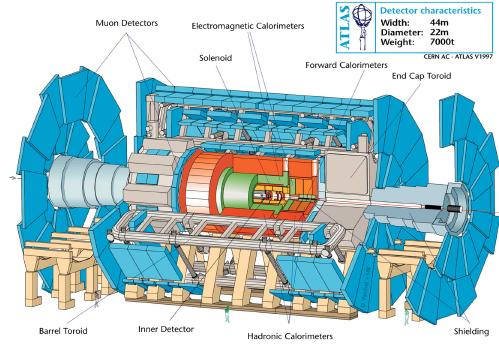Taking a closer look at LHC


ATLAS is a worldwide collaboration comprising over 5500 members and almost 3000 scientific authors. and engineers from 181 institutions in 42 countries.
More information here...
|
Together with CMS, it contributed to the discovery of the Higgs boson in 2012-13. ATLAS may also provide the answer for the mysterious dark matter and energy of the Universe and look for extra dimensions of spacetime. This detector is designed to be capable of discovering new particles and new phenomena expected from extensions of the Standard Model such as supersymmetry, and help to better understand the properties of the Higgs boson. (discovered in this detector together with CMS in 2012-13). |
 |
ATLAS Live
(Taken from MELTRONX ©2009-2024. A Real Frisco Kid Production Not Affiliated with CERN)
At each Long Shutdown (LS) the various accelerators, detectors and other devices undergo major maintenance, consolidation and upgrade operations.
Some of the improvements in ATLAS in LS2 (2019-2022) were carried out in the so-called Small WheelsT, detectors designed to catch muons. Even though “small” is part of their name, each wheel is 9 meters in diameter. These wheels hold 16 wedge-shaped detector slices (which in turn, consist of 16 detecting layers each). The New Small Wheels help ATLAS to more accurately measure the momenta and trajectories of muons created during the high energy collisions inside the LHC
ATLAS scientists have also updated their detector’s trigger system—which is responsible for quickly filtering the data coming off the detector—and the software that processes, reconstructs and analyzes the data.
[These comments are based on What’s new for LHC Run 3? By Sarah Charley. Symmetry (A joint Fermilab/SLAC publication)]
In more detail we can see the improvements made to this detector during the LS2 in the following image:
All information in Toda la información en ATLAS Upgrades LS2
The image at the bottom of the DETECTORS Section shows some of those performed on the larger detectors during LS2 (2019-2022).
|
AUTHORS Xabier Cid Vidal, PhD in experimental Particle Physics for Santiago University (USC). Research Fellow in experimental Particle Physics at CERN from January 2013 to Decembre 2015. He was until 2022 linked to the Department of Particle Physics of the USC as a "Juan de La Cierva", "Ramon y Cajal" fellow (Spanish Postdoctoral Senior Grants), and Associate Professor. Since 2023 is Senior Lecturer in that Department.(ORCID). Ramon Cid Manzano, until his retirement in 2020 was secondary school Physics Teacher at IES de SAR (Santiago - Spain), and part-time Lecturer (Profesor Asociado) in Faculty of Education at the University of Santiago (Spain). He has a Degree in Physics and a Degree in Chemistry, and he is PhD for Santiago University (USC) (ORCID). |
CERN CERN Experimental Physics Department CERN and the Environment |
LHC |
IMPORTANT NOTICE
For the bibliography used when writing this Section please go to the References Section
© Xabier Cid Vidal & Ramon Cid - rcid@lhc-closer.es | SANTIAGO (SPAIN) |






